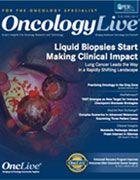Publication
Article
Oncology Live®
Nab-Paclitaxel Paired With Anti-PD-L1 Immunotherapies in TNBC Studies
Author(s):
Combination regimens that pair nab-paclitaxel with PD-L1 checkpoint blockade immunotherapy agents are emerging as a robust area of investigation in triple-negative breast cancer, bolstered by clinical trial results that establish the chemotherapeutic agent as an effective partner for other therapies.
Combination regimens that pair nab-paclitaxel (Abraxane) with PD-L1 checkpoint blockade immunotherapy agents are emerging as a robust area of investigation in triple-negative breast cancer (TNBC), bolstered by clinical trial results that establish the chemotherapeutic agent as an effective partner for other therapies.
Although nab-paclitaxel has been combined in some studies with other chemotherapies, the focus is shifting to regimens that include immunotherapies as the efficacy of that approach continues to grow. Nab-paclitaxel, an albumin-bound form of paclitaxel, is indicated for patients with metastatic breast cancer after prior chemotherapy.
Several later-stage trials evaluating nab-paclitaxel in combination with anti—PD-L1 agents as neoadjuvant or first-line therapy for patients with TNBC are planned or underway (Table). The TNBC studies are part of a broader landscape in which nab-paclitaxel is partnered with PD-1 or PD-L1 inhibitors; a recent review counted approximately 20 ongoing trials in breast cancer, non—small cell lung cancer, and other malignancies.1
Early clinical trial findings indicate that nab-paclitaxel, which delivers faster and greater tissue penetration than paclitaxel, may amplify the antitumor activity of checkpoint blockade immunotherapy agents without overlapping or worsening immune-related toxicities.1
In a phase Ib trial, upfront treatment with the PD-L1 inhibitor atezolizumab (Tecentriq) plus nab-paclitaxel showed a confirmed objective response rate (ORR) of 46% in patients with metastatic TNBC (n = 13; 95% CI, 19-75).2 The complete response in the frontline setting was 8%. The progression-free survival (PFS) and overall survival (OS) data were not yet mature.
Figure 1. Differences in length of stay and complications before and after implementation of enhanced recovery

The potential for nab-paclitaxel combinations in TNBC was discussed recently at the 2016 San Antonio Breast Cancer Symposium in the context of findings from the phase II tnAcity study.3 “In the metastatic setting, where patients are going to get multiple lines of therapy, looking at the toxicity profile that Abraxane offers has been quite welcomed. It improves neuropathy issues and myelosuppression, leaving itself very open to be partnered with other agents,” said Denise A. Yardley, MD, senior investigator at the Sarah Cannon Research Institute, who presented the tnAcity findings.
“It is very attractive in the triple-negative population because it partners very well with immunotherapy,” Yardley said. “Because it does not require steroid premedication, which may mitigate some of the benefits of immune therapy, it is going in that direction, too.”
The tnAcity study, which was initiated in 2013, was originally designed to advance the superior of the 2 nab-paclitaxel doublets into a 550-patient phase III study comparing the doublet with gemcitabine/carboplatin. However, the introduction of effective immunotherapies since the study was designed caused the investigators to reconsider a chemotherapeutic approach in favor of combination strategies with PD-1/PD-L1 inhibitors.
In the tnAcity trial, the combination of nab-paclitaxel and carboplatin reduced the risk of progression or death by 40% compared with 2 other chemotherapy doublets as a frontline therapy for patients with metastatic TNBC.2
The median PFS was 7.4 months with the nab-paclitaxel plus carboplatin regimen compared with 5.4 months for nab-paclitaxel plus gemcitabine (HR, 0.60; 95% CI, 0.39- 0.93; P = .02) and 6.0 months for gemcitabine plus carboplatin (HR, 0.61; 95% CI, 0.39-0.94; P = .03). The 12-month PFS rate was 27% with nab-paclitaxel/carboplatin compared with 13% and 11% for nab-paclitaxel/gemcitabine and gemcitabine/carboplatin, respectively.
The study randomized 191 untreated patients with metastatic TNBC to receive the combination of carboplatin and gemcitabine (n = 66) or nab-paclitaxel with carboplatin (n = 64) or gemcitabine (n = 61). Nab-paclitaxel was administered at 125 mg/m2, carboplatin at area under the curve 2, and gemcitabine was given at 1000 mg/m2. In each arm, treatment was administered on day 1 and 8 every 3 weeks.
The ORR with nab-paclitaxel/carboplatin was 72%, which consisted of 7 complete responses (CR; 11%) and 39 partial responses (PR; 61%). The ORR was 39% with nab-paclitaxel/gemcitabine and 44% with gemcitabine/carboplatin. The CR rate in each of these arms was 8%.
Median OS was 16.4 months with nab-paclitaxel/carboplatin compared with 12.1 months with nab-paclitaxel/gemcitabine (HR, 0.66; 0.42-1.04; P = .07) and 12.6 months for gemcitabine/carboplatin (HR, 0.74; 0.48-1.16; P = .18). These findings were not statistically significant.
The most common grade ≥3 treatment-emergent AEs observed in the nab-paclitaxel/carboplatin, nab-paclitaxel/gemcitabine, and carboplatin/gemcitabine arms, respectively, were neutropenia (42%, 27%, 52%), anemia (13%, 12%, 27%), thrombocytopenia (9%, 7%, 28%), leukopenia (6%, 3%, 11%), febrile neutropenia (5%, 2%, 0%), fatigue (3%, 15%, 3%), and peripheral neuropathy (5%, 7%, 2%). Growth factors were needed for 45%, 26%, and 47% of patients in each arm, respectively.
References
- Soliman HH. Nab-paclitaxel as a potential partner with checkpoint inhibitors in solid tumors. OncoTargets Ther. 2016;10:101-102. doi:10.2147/OTT.S122974. eCollection 2017.
- Adams S, Diamond JR, Hamilton EP, et al. Phase Ib trial of atezolizumab in combination with nab-paclitaxel in patients with metastatic triple-negative breast cancer (mTNBC). J Clin Oncol. 2016;34(suppl; abstr 1009).
- Yardley D, Coleman R, Conte P, et al. nab-paclitaxel + carboplatin or gemcitabine vs gemcitabine/carboplatin as first-line treatment for patients with triple-negative metastatic breast cancer: results from the randomized phase 2 portion of the tnAcity trial. Presented at: 2016 San Antonio Breast Cancer Symposium; December 6-10, 2016; San Antonio, TX. Abstract P5-15-03.










